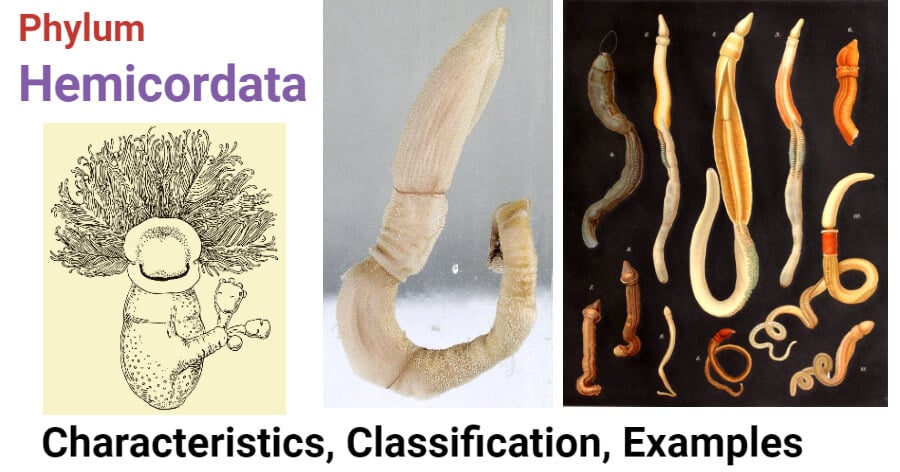Interesting Science Videos
Hemichordata Definition
Hemichordata (Gr., hemi, half; chorde, cord) means they are ‘half’ of ‘part’ chordates, a fact that is disputed. They are usually vermiform, solitary, or colonial enterocoelous coelomate animals with an intra-epidermal nervous system and a pre-oral with or without gill-slits and without typical nephridia.
Phylum Hemichordata Characteristics
- They are exclusively marine, solitary or colonial, mostly tubicolous.
- Their body is soft, fragile, vermiform, unsegmented, bilaterally symmetrical, and triploblastic.
- The body is divisible into proboscis, collar, and trunk.
- Body wall with a single-layered epidermis with mucous glands. No dermis.
- Coelom enterocoelous, divisible into protocoel, mesocoel and metacoel.
- Buccal diverticulum, earlier considered as the notochord, present in the proboscis.
- The alimentary canal is a straight, complete, or U-shaped tube.
- Dorso-lateral pharyngeal gill-slits, when present, one to several pairs. Ciliary filter feeders.
- Simple, open, and well-developed circulatory system, including a dorsal heart and 2 longitudinal vessels, one dorsal and one ventral.
- Excretion by a single glomerulus situated in the proboscis.
- Primitive type nervous system consisting mainly of subepidermal nerve plexus. Dorsal collar nerve cord hollow.
- Reproduction is mainly sexual. Sexes usually separate. Gonads one to several pairs.
- External fertilization in seawater.
- Development direct or indirect with a free-swimming tornaria larva.
- Examples: Balanoglossus, Saccoglossus, Rhabdopleura, Atubaria, Dendrograptus.
Read Also: Phylum Mollusca- characteristics, classification, examples

Image Source: Luis Fernández García, Necrophorus, and Spengel, Johann Wilhelm.
Phylum Hemichordata Classification
Hemichordata includes about 80 known species and has been divided into 4 classes.
Class 1- Enteropneusta (Gr., enteron, gut +pneustos, breathed)
- Commonly called “acorn” or “tongue worm”.
- Solitary, free-swimming, or burrowing animals.
- Elongated, vermiform body with no stalk.
- The body consists of the proboscis, collar, and trunk; collar without tentaculated arms(lophophore).
- Proboscis cylindrical and tapering.
- Straight alimentary canal; mouth and anus at opposite ends. Filter feeding.
- Numerous pairs of U-shaped gill-slits.
- 2 pairs of hepatic caeca present in the middle of the trunk.
- Sexes separate. Gonads numerous, scan-like.
- Development with or without tornaria larva.
- Asexual reproduction is lacking.
- Examples: Balanoglossus, Saccoglossus, Protoglossus, Ptychodera.
Class 2. Pterobranchia (Gr., pteron, feather +branchion, gill)
- Sedentary, solitary or colonial, sessile, and tubicolous.
- Living inside secreted chitinous tubes.
- Body short, compact, with stalk for attachment.
- Proboscis with ciliated tentacles to produce ciliary feeding currents of water.
- Collar bearing ciliated arms(lophophore).
- One pair of gill-slits or none, never U-shaped.
- U-shaped alimentary canal. Anus dorsal lying near the mouth.
- Separate or united sexes. Gonads single or one pair.
- Development direct, may or may not include a free-swimming larval stage.
- Asexual reproduction by budding in some form.
Order 1. Rhabdopleurida
- Colonial, zooids connected by a stolon.
- Collar with 2 tentaculated arms.
- No gill-slits.
- Single gonad.
- Example: single genus Rhabdopleura.
Order 2. Cephalodiscida
- Solitary or several zooids living unconnected in a common gelatinous case.
- Collar with several tentaculated arms.
- Single pair of gill-slits present.
- Single pair of gonads present.
- Examples: Cephalodiscus, Atubaria.
Class 3. Planctosphaeroidea
- Class is represented by a few small, rounded, transparent, and pelagic larvae, supposed to be specialized tornaria of some unknown hemichordate termed Planctosphaera pelagica.
- Larval body covered by extensively branched ciliary bands.
- The alimentary canal is L-shaped.
Class 4. Graptolite
- Extinct colonial hemichordates, mainly known from fossil structures of their tubes.
- These are abundant in the Ordovician and Silurian periods.
- Each animal is housed in a zooid.
- Their tubular chitinous skeleton and colonial habits show an affinity with Rhabdopleura.
- Example: Dendrograptus.
References
- Kotpal RL. 2017. Modern Text Book of Zoology- Invertebrates. 11th Edition. Rastogi Publications.
- Jordan EL and Verma PS. 2018. Invertebrate Zoology. 14th Edition. S Chand Publishing.
